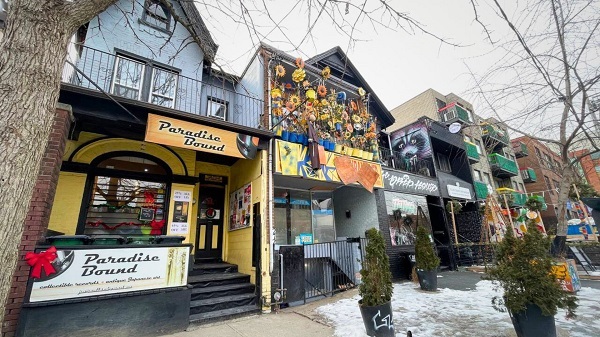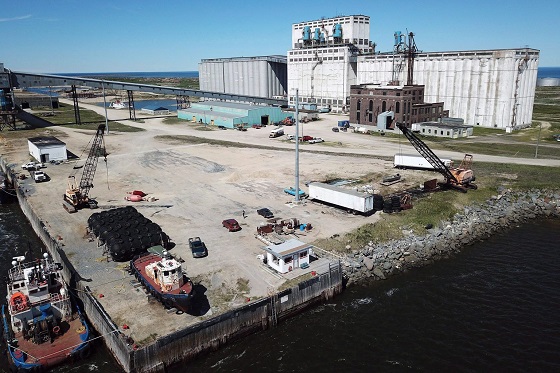Addictions
Kensington Market’s overdose prevention site is saving lives but killing business

Business owners and residents weigh in on the controversial closure of Kensington Market’s overdose prevention site
Toronto’s Kensington Market is a bohemian community knit together by an eclectic symphony of cultures, sounds and flavours.
However, debate has been raging in the community over the potential closure of a local overdose consumption site, which some see as a life-saving resource and others consider a burden on the community.
Grey Coyote, who owns Paradise Bound record shop, believes that the Kensington Market Overdose Prevention Site is fuelling theft and property damage. He plans on shutting his store, which is adjacent to the site, after 25 years of operation.
Other nearby business owners have decided to stay. But they, too, are calling for change.
“The merchants in the market are the ones taking the brunt of this … especially the ones closest to [the overdose prevention site],” said David Beaver, co-owner of Wanda’s Pie in the Sky, a nearby bakery.
“There’s a larger issue at hand here,” Beaver said. “We have to help these people out, but perhaps [the status quo] is not the way to go about it.”
In an effort to change the status quo, Ontario recently passed a law prohibiting overdose prevention sites from operating within 200 metres of schools or daycares. The law could force the Kensington Market Overdose Prevention Site to close, although it is challenging the decision.
Coyote says he plans on leaving the neighbourhood regardless. The high concentration of social programs in the area will make continued theft, property damage and defacement likely, he says.
“They’re all still going to be there,” he said.
Court challenge
Ontario’s decision to close supervised consumption sites near schools and daycares affects 10 sites across the province.
The province plans to transition all nine provincially funded overdose prevention sites into Homelessness and Addiction Recovery Treatment (HART) Hubs. These hubs will offer drug users a range of primary care and housing solutions, but not supervised consumption, needle exchanges or the “safe supply” of prescription drugs.
The tenth site, Kensington Market Overdose Prevention Site, is not eligible to become a HART Hub because it is not provincially funded.
In response, The Neighbourhood Group, the social agency that runs the Kensington site, has filed a lawsuit against the province. It claims the closure order violates the Charter rights of the site’s clients by increasing their risk of death and disease.
“There will be a return of [overdose] deaths that would be preventable,” said Bill Sinclair, CEO of The Neighbourhood Group.
“Our neighbours include people who use these sites and … they are very frightened. They want to know what’s going to happen to them if we close.”
In response to the lawsuit, the province has initiated an investigation on the site’s impact on the community. It has enlisted two ex-police officers to canvas the market, question locals and gather information about the site in preparation for the legal challenge.
“Ontario is collecting evidence from communities affected by supervised consumption sites,” said Keesha Seaton, a media spokesperson for Ontario’s Ministry of the Attorney General.
“Ontario’s responding evidence in the court challenge will be served on January 24.”
 |
Kensington Market Overdose Prevention Site in Toronto; Dec. 18, 2024. [Photo credit: Alexandra Keeler]
Bad for business
The Kensington Market Overdose Prevention Site sits at the northern entrance of Spadina Avenue, a key thoroughfare into the heart of Kensington Market. It is located within St. Stephen’s Community House, a former community centre.
The site was added to the community centre in 2018 in response to a surge of overdoses in the area. It is funded through federal grants and community donations.
Within the site’s 200-metre radius are Westside Montessori School, Kensington Kids Early Learning Centre and Bellevue Child Care Centre. Bellevue is operated by The Neighbourhood Group, the same organization that operates the overdose prevention site.
The site serves an average of 154 clients per month. It reversed 50 overdoses in 2024, preventing fatalities.
But while the site has saved lives, shop owners claim it is killing business.
“[Kensington] is a very accepting market and very understanding, but [the overdose prevention site is] just not conducive to business right now,” said Mike Shepherd, owner of Trinity Common beer hall — located across the street from the site — and chair of the Kensington Market Business Improvement Area.
Shepherd says it has become more common to find broken glass, needles and condoms outside his bar in recent years. He has also had to deal with stolen propane heaters and vandalism, including a wine bottle thrown at his car.
Shepherd attributes some of these challenges to a growing homeless population and increased drug use in the neighborhood. He says these issues became particularly acute after Covid hit and the province cut funding for community programs once offered by St. Stephen’s.
Inside his bar, he has handled multiple overdoses, administering naloxone and calling ambulances, and has had to physically remove disruptive patrons.
“I don’t have problems throwing people out of my establishment when they’re … getting violent or causing problems, but my staff shouldn’t have to deal with that,” he said.
“I’m literally watching somebody smoke something from a glass pipe right now,” he said, staring across the street from his bar window as he spoke to Canadian Affairs.
 |
Trinity Common beer hall and restaurant in Toronto’s Kensington Market; January 19, 2025. [Photo credit: Alexandra Keeler]
Still, he is empathetic.
“A lot of people who are drug addicted are self-diagnosing for mental traumas,” said Shepherd. “Sometimes, when they go down those deep roads, they go off the tracks.”
Other business owners in the area share similar concerns.
Bobina Attlee, the owner of Otto’s Berlin Döner, has struggled to deal with discarded syringes, stolen bins and sanitation concerns like urine and feces.
These issues prevented her from joining the CaféTO program, which allows restaurants and bars to expand their outdoor dining space during the summer months.
Sid Dichter, owner of Supermarket Restaurant and Bar, has dealt with loitering, break-ins and drug paraphernalia being left behind on his patio day after day.
Some business owners, like Coyote, expressed harsher criticisms.
“Weak politicians and law enforcement have been infiltrated by the retarded, woke mafia,” Coyote said, referring to what he sees as overly lenient harm reduction policies and social programs in “liberal” cities.
Toronto Police Service data show increases in auto and bike thefts and break-and-enters in Kensington Market from 2014 to 2023. Auto thefts rose from 23 in 2014 to 50 in 2023, bike thefts from 92 to 137, and break-and-enters from 103 to 145.
Our content is always free. Subscribe to get BTN’s latest news and analysis, or donate to our journalism fund.
Kensington Market’s city councillor, Dianne Saxe, said she has received numerous complaints from constituents about disorder in the area.
In an email to Canadian Affairs, she cited complaints about “feces, drug trafficking, harassment, shoplifting, theft from yards and porches, trash, masturbation in front of children, and shouting at parents and teachers.”
However, Saxe noted it is difficult to determine what portion of these problems are linked to the overdose prevention site, as opposed to factors like nearby homeless encampments.
Encampments emerged at the Church of Saint Stephen-in-the-Fields on Bellevue Avenue in the spring of 2022 and were cleared in November 2023.
 |
Supermarket Bar and Variety in Toronto’s Kensington Market; January 19, 2025. [Photo credit: Alexandra Keeler]
‘Fair share’
Wanda’s Pie in the Sky is located just a few doors down from the Kensington Market Overdose Prevention Site. Beaver, the store’s co-owner, says Wanda’s has always provided food and coffee to clients of the site.
However, issues escalated during the pandemic. Beaver had to deal with incidents like drug use in the restaurant’s restrooms, theft, vandalism and violent outbreaks.
“We try to deal with it on a very compassionate level, but there’s only so much we can do,” said Beaver.
Despite the messes left on his patio, Dichter, who owns the Supermarket Restaurant and Bar, has also developed relationships with site clients.
“I’ve talked to a lot of them, and most of them are very good human beings,” he said. “For the most part, they just have bad luck in life.”
 |
Wanda’s Pie in the Sky bakery and cafe in Toronto’s Kensington Market; January 19, 2025. [Photo credit: Alexandra Keeler]
Reverend Canon Maggie Helwig has been a priest at Church of Saint Stephen-in-the-Fields since 2013. She described the overdose prevention site as a safe, well-run space where many people have connected to recovery resources.
“It’s clear to me that the overdose prevention site has been a positive influence in the neighbourhood,” she told Canadian Affairs in an email.
“We need more access to harm reduction, not less, and … closing the site will lead to more public drug use, more deaths from toxic drugs, and fewer people connecting to recovery resources.”
Sinclair, CEO of The Neighbourhood Group, described Kensington Market as “an accepting place for people who are sometimes different or excluded from society … it’s been a place where people have practised tolerance.”
“But sometimes it does feel that some neighbourhoods are doing more than their fair share,” he added.
Shepherd, of Trinity Common beer hall, counted five different social service agencies within a two-block radius of the market. These range from food banks and homeless shelters to the Centre for Addiction and Mental Health.
“When you have that kind of social services infrastructure in one area, it’s going to draw the people that need it to this area and overburden the neighbourhood,” said Shepherd.
 |
Late-Victorian bay-and-gable residential buildings in Toronto’s Kensington Market; January 19, 2025. [Photo credit: Alexandra Keeler]
Systemic issues
Some sources pointed to potential root causes of the growing tensions in Kensington Market.
“We mostly blame the provincial government,” said Beaver, referencing funding cuts by the Ford government that began in 2019.
“They cut the funding to the city, and the city can only do so much with whatever budget they have.”
Provincial funding reductions slashed millions from Toronto Public Health’s budget, straining harm reduction, infectious disease control and community health programs.
“The [overdose prevention site] closure is a provincial decision,” said Councillor Saxe. “I was not consulted [and] I am not aware of any evidence that supports Ford’s decision.
A Toronto Public Health report tabled Jan. 20 warns that closing overdose prevention sites could increase fatal overdoses and strain emergency responders.
The report, prepared by the city’s acting Medical Officer of Health Na-Koshie Lamptey, urges the province to reconsider its decision to exclude safe consumption services from the HART Hubs.
The province’s decision to close sites located near schools and daycares came after a mother of two was fatally shot in a gunfight outside a safe consumption site in Toronto’s Riverdale neighbourhood.
Ontario has also cited crime and public safety concerns as reasons for prohibiting supervised consumption services near centres with children. Police chiefs and sergeants in the Ontario cities of London and Ottawa have additionally raised concerns about prescription drugs dispensed through safer supply programs being diverted to the black market.
For some Kensington Market business owners, the answer is to move overdose prevention sites elsewhere.
“Put our safe injection sites as a wing or an area of the hospital,” said Shepherd, referring to Toronto Western Hospital, on the east side of the Kensington Market neighbourhood.
But another local resident, Andy Stevenson, argues for leaving things as they are. “Leave it alone. Just leave it alone,” said Stevenson, whose home is a five-minute walk from the site. “It’s going to become chaotic if they close it down.”
Stevenson says she has felt a deep connection to the market since her teenage years. She spends her leisure time there and continues to do all her shopping in the area.
“When you choose to live around here, it’s a reality that there are drug addicts, homeless people and street people — It’s a fact of life,” she said.
“So you can’t [complain] about it … move to suburbia.”
This article was produced through the Breaking Needles Fellowship Program, which provided a grant to Canadian Affairs, a digital media outlet, to fund journalism exploring addiction and crime in Canada. Articles produced through the Fellowship are co-published by Break The Needle and Canadian Affairs.
Subscribe to Break The Needle. Our content is always free – but if you want to help us commission more high-quality journalism, consider getting a voluntary paid subscription.
Addictions
Activists Claim Dealers Can Fix Canada’s Drug Problem

By Adam Zivo
We should learn from misguided experiments with activist-driven drug ideologies.
Some Canadian public-health researchers have argued that the nation’s drug dealers, far from being a public scourge, are central to the cause of “harm reduction,” and that drug criminalization makes it harder for them to provide this much-needed “mutual aid.” Incredibly, these ideas have gained traction among Canada’s policymakers, and some have even been put into practice.
Gillian Kolla, an influential harm-reduction activist and researcher, spearheaded the push to whitewash drug trafficking in Canada. Over the past decade, she has advocated for many of the country’s failed laissez-faire drug policies. In her 2020 doctoral dissertation, she described her hands-on research into Toronto’s “harm reduction satellite sites”—government-funded programs that paid drug users to provide services out of their homes.
The sites Kolla studied were operated by the nonprofit South Riverdale Community Health Centre (SRCHC) in Toronto. Addicts participating in the programs received $250 per month in exchange for distributing naloxone and clean paraphernalia (needles and crack pipes, for example), as well as for reversing overdoses and educating acquaintances on safer consumption practices. At the time of Kolla’s research (2016–2017), the SRCHC was operating nine satellite sites, which reportedly distributed about 1,500 needles and syringes per month.
Canada permits supervised consumption sites—facilities where people can use drugs under staff oversight—to operate so long as they receive an official exemption via the federal Controlled Drugs and Substances Act. As the sites Kolla observed did not receive exemptions, they were certainly illegal. Kolla herself acknowledged this in her dissertation, writing that she, with the approval of the University of Toronto, never recorded real names or locations in her field notes, in case law enforcement subpoenaed her research data.
Even so, the program seems to have enjoyed the blessing of Toronto’s public health officials and police. The satellite sites received local funding from 2010 onward, after a decade of operating on a volunteer basis, apparently with special protection from law enforcement. In her dissertation, Kolla described how SRCHC staff trained police officers to leave their sites alone, and how satellite-site workers received special ID badges and plaques to ward off arrest.
Kolla made it clear that many of these workers were not just addicts but dealers, too, and that tolerance of drug trafficking was a “key feature” of the satellite sites. She even described, in detail, how she observed one of the site workers packaging and selling heroin alongside crackpipes and needles.
In her dissertation, Kolla advocated expanding this permissive approach. She claimed that traffickers practice harm reduction by procuring high-quality drugs for their customers and avoiding selling doses that are too strong.
“Negative framings of drug selling as predatory and inherently lacking in care make it difficult to perceive the wide variety of acts of mutual aid and care that surround drug buying and selling as practices of care,” she wrote.
In truth, dealers routinely sell customers tainted or overly potent drugs. Anyone who works in the addiction field can testify that this is a major reason that overdose deaths are so common.
Ultimately, Kolla argued that “real harm reduction” should involve drug traffickers, and that criminalization creates “tremendous barriers” to this goal.
The same year she published her dissertation, Kolla cowrote a paper in the Harm Reduction Journal with her Ph.D. supervisor at the Dalla Lana School of Public Health. The article affirmed the view that drug traffickers are essential to the harm-reduction movement. Around this time, the SRCHC collaborated with the Toronto-based Parkdale Queen West Community Health Centre— the only other organization running such sites—to produce guidelines on how to replicate and scale up the experiment.
Thankfully, despite its local adoption, this idea did not catch on at the national level. It was among the few areas in the early 2020s where Canada did not fully descend into addiction-enabling madness. Yet, like-minded researchers still echo Kolla’s work.
In 2024, for example, a group of American harm-reduction advocates published a paper in Drug and Alcohol Dependence Reports that concluded, based on just six interviews with drug traffickers in Indianapolis, that dealers are “uniquely positioned” to provide harm-reduction services, partly because they are motivated by “the moral imperative to provide mutual aid.” Among other things, the authors argued that drug criminalization is harmful because it removes dealers from their social networks and prevents them from enacting “community-based practices of ethics and care.”
It’s instructive to review what ultimately happened with the originators of this movement—Kolla and the SRCHC. Having failed to whitewash drug trafficking, Kolla moved on to advocating for “safer supply”—an experimental strategy that provides addicts with free recreational drugs to dissuade use of riskier street substances. The Canadian government funded and expanded safer supply, thanks in large part to Kolla’s academic work. It abandoned the experiment after news broke that addicts resell their safer supply on the black market to buy illicit fentanyl, flooding communities with diverted opioids and fueling addiction.
The SRCHC was similarly discredited after a young mother, Karolina Huebner-Makurat, was shot and killed near the organization’s supervised consumption site in 2023. Subsequent media reports revealed that the organization had effectively ignored community complaints about public safety, and that staff had welcomed, and even supported, drug traffickers. One of the SRCHC’s harm-reduction workers was eventually convicted of helping Huebner-Makurat’s shooter evade capture by hiding him from the police in an Airbnb apartment and lying to the police.
There is no need for policymakers to repeat these mistakes, or to embrace its dysfunctional, activist-driven drug ideologies. Let this be another case study of why harm-reduction policies should be treated with extreme skepticism.
Our content is always free
If you want to help us commission more high-quality journalism,
consider getting a voluntary paid subscription.
Addictions
Canadian gov’t not stopping drug injection sites from being set up near schools, daycares

From LifeSiteNews
Canada’s health department told MPs there is not a minimum distance requirement between safe consumption sites and schools, daycares or playgrounds.
So-called “safe” drug injection sites do not require a minimum distance from schools, daycares, or even playgrounds, Health Canada has stated, and that has puzzled some MPs.
Canadian Health Minister Marjorie Michel recently told MPs that it was not up to the federal government to make rules around where drug use sites could be located.
“Health Canada does not set a minimum distance requirement between safe consumption sites and nearby locations such as schools, daycares or playgrounds,” the health department wrote in a submission to the House of Commons health committee.
“Nor does the department collect or maintain a comprehensive list of addresses for these facilities in Canada.”
Records show that there are 31 such “safe” injection sites allowed under the Controlled Drugs And Substances Act in six Canadian provinces. There are 13 are in Ontario, five each in Alberta, Quebec, and British Columbia, and two in Saskatchewan and one in Nova Scotia.
The department noted, as per Blacklock’s Reporter, that it considers the location of each site before approving it, including “expressions of community support or opposition.”
Michel had earlier told the committee that it was not her job to decide where such sites are located, saying, “This does not fall directly under my responsibility.”
Conservative MP Dan Mazier had asked for limits on where such “safe” injection drug sites would be placed, asking Michel in a recent committee meeting, “Do you personally review the applications before they’re approved?”
Michel said that “(a)pplications are reviewed by the department.”
Mazier stated, “Are you aware your department is approving supervised consumption sites next to daycares, schools and playgrounds?”
Michel said, “Supervised consumption sites were created to prevent overdose deaths.”
Mazier continued to press Michel, asking her how many “supervised consumption sites approved by your department are next to daycares.”
“I couldn’t tell you exactly how many,” Michel replied.
Mazier was mum on whether or not her department would commit to not approving such sites near schools, playgrounds, or daycares.
An injection site in Montreal, which opened in 2024, is located close to a kindergarten playground.
Conservative Party leader Pierre Poilievre has called such sites “drug dens” and has blasted them as not being “safe” and “disasters.”
Records show that the Liberal government has spent approximately $820 million from 2017 to 2022 on its Canadian Drugs and Substances Strategy. However, even Canada’s own Department of Health admitted in a 2023 report that the Liberals’ drug program only had “minimal” results.
Recently, LifeSiteNews reported that the British Columbia government decided to stop a so-called “safe supply” free drug program in light of a report revealing many of the hard drugs distributed via pharmacies were resold on the black market.
British Columbia Premier David Eby recently admitted that allowing the decriminalization of hard drugs in British Columbia via a federal pilot program was a mistake.
Former Prime Minister Justin Trudeau’s loose drug initiatives were deemed such a disaster in British Columbia that Eby’s government asked Trudeau to re-criminalize narcotic use in public spaces, a request that was granted.
Official figures show that overdoses went up during the decriminalization trial, with 3,313 deaths over 15 months, compared with 2,843 in the same time frame before drugs were temporarily legalized.
-

 Carbon Tax7 hours ago
Carbon Tax7 hours agoCarney fails to undo Trudeau’s devastating energy policies
-

 Business2 days ago
Business2 days agoNew airline compensation rules could threaten regional travel and push up ticket prices
-

 Censorship Industrial Complex2 days ago
Censorship Industrial Complex2 days agoMove over Soviet Russia: UK Police Make 10,000 Arrests Over “Offensive” Online Speech
-

 Digital ID2 days ago
Digital ID2 days agoRoblox to Mandate Facial and ID Verification
-

 Business2 days ago
Business2 days agoWill the Port of Churchill ever cease to be a dream?
-

 Business3 hours ago
Business3 hours agoBudget 2025: Ottawa Fakes a Pivot and Still Spends Like Trudeau
-

 Daily Caller1 day ago
Daily Caller1 day agoTrump Gives Zelenskyy Until Thanksgiving To Agree On Peace Deal, With U.S. Weapons And Intel On The Line
-

 Business1 day ago
Business1 day agoI Was Hired To Root Out Bias At NIH. The Nation’s Health Research Agency Is Still Sick











